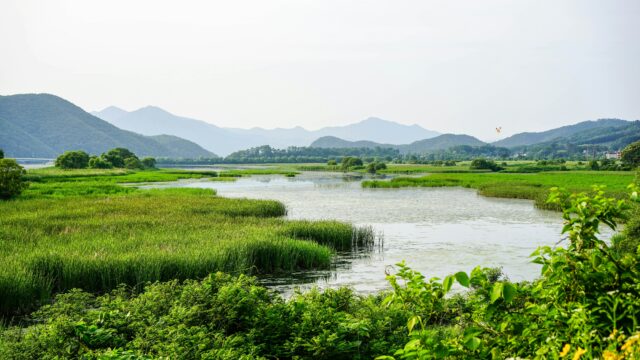We can't fight climate change without valuing nature
A new study finds that climate economics could be grossly underestimating the cost of damages to natural systems.

The GEC Insights series is a curated collection of online articles at the intersection of environment and economics, each written by leading thinkers from the worlds of business, government and civil society. Part of our Economics for Nature project, they bring together diverse perspectives to answer the question: how can we re-design our economies to protect and restore nature? This article originally appeared at Yale Climate Connections and is republished with permission.
A new study in Nature Sustainability incorporates the damages that climate change does to healthy ecosystems into standard climate-economics models. The key finding in the study by Bernardo Bastien-Olvera and Frances Moore from the University of California at Davis: The models have been underestimating the cost of climate damages to society by a factor of more than five.
Their study concludes that the most cost-effective emissions pathway results in just 1.5 degrees Celsius (2.7 degrees Fahrenheit) additional global warming by 2100, consistent with the “aspirational” objective of the 2015 Paris Climate Agreement.
Models that combine climate science and economics, called “integrated assessment models” (IAMs), are critical tools in developing and implementing climate policies and regulations. In 2010, an Obama administration governmental interagency working group used IAMs to establish the social cost of carbon – the first federal estimates of climate damage costs caused by carbon pollution. That number guides federal agencies required to consider the costs and benefits of proposed regulations.
“ Economic models of climate have long been criticized by those convinced they underestimate the costs of climate damages, in some cases to a degree that climate scientists consider absurd.”
Given the importance of the social cost of carbon to federal rulemaking, some critics have complained that the Trump EPA used what they see as creative accounting to slash the government’s estimate of the number. In one of his inauguration day Executive Orders, President Biden established a new Interagency Working Group to re-evaluate the social cost of all greenhouse gases.
IAMs often have long been criticized by those convinced they underestimate the costs of climate damages, in some cases to a degree that climate scientists consider absurd.
Perhaps the most prominent IAM is the Dynamic Integrated Climate-Economy (DICE) model, for which its creator, William Nordhaus, was awarded the 2018 Nobel Prize in Economic Sciences. Judging by DICE, the economically optimal carbon emissions pathway – that is, the pathway considered most cost-effective – would lead to a warming increase of more than 3°C (5.4°F) from pre-industrial temperatures by 2100 (under a 3% discount rate). IPCC has reported that reaching this level of further warming could likely result in severe consequences, including substantial species extinctions and very high risks of food supply instabilities.
In their Nature Sustainability study, the UC Davis researchers find that when natural capital is incorporated into the models, the emissions pathway that yields the best outcome for the global economy is more consistent with the dangerous risks posed by continued global warming described in the published climate science literature.
Accounting for climate change degrading of natural capital
Natural capital includes elements of nature that produce value to people either directly or indirectly. “DICE models economic production as a function of generic capital and labor,” Moore explained via email. “If instead you think natural capital plays some distinct role in economic production, and that climate change will disproportionately affect natural capital, then the economic implications are much larger than if you just roll everything together and allow damage to affect output.”
Bastien-Olvera offered an analogy to explain the incorporation of natural capital into the models: “The standard approach looks at how climate change is damaging ‘the fruit of the tree’ (market goods); we are looking at how climate change is damaging the ‘tree’ itself (natural capital).”
In an adaptation of DICE they call “GreenDICE,” the authors incorporated climate impacts on natural capital via three pathways:
The first pathway accounts for the direct influence of natural capital on market goods. Some industries like timber, agriculture, and fisheries are heavily dependent on natural capital, but all goods produced in the economy rely on these natural resources to some degree.
According to GreenDICE, this pathway alone more than doubles the model’s central estimate of the social cost of carbon in 2020 from $28 per ton in the standard DICE model to $72 per ton, and the new economically optimal pathway would have society limit global warming to 2.2°C (4°F) above pre-industrial temperatures by 2100.
The second pathway incorporates ecosystem services that don’t directly feed into market goods. Examples are the flood protection provided by a healthy mangrove forest, or the recreational benefits provided by natural places.
In the study, this second pathway nearly doubles the social cost of carbon once again, to $133 per ton in 2020, and it lowers the most cost-effective pathway to 1.8°C (3.2°F) by 2100.
Finally, the third pathway includes non-use values, which incorporate the value people place on species or natural places, regardless of any good they produce. The most difficult to quantify, this pathway could be measured, for instance, by asking people how much they would be willing to pay to save one of these species from extinction.

In GreenDICE, non-use values increase the social cost of carbon to $160 per ton of carbon dioxide in 2020 (rising to about $300 in 2050 and $670 per ton in 2100) and limit global warming to about 1.5°C (2.8°F) by 2100 in the new economically optimal emissions pathway.
(Note for economics wonks – the model runs used a 1.5% pure rate of time preference.)
Climate economics findings increasingly reinforce Paris targets
It may come as no surprise that destabilizing Earth’s climate would be a costly proposition, but key IAMs have suggested otherwise. Based on the new Nature Sustainability study, the models have been missing the substantial value of natural capital associated with healthy ecosystems that are being degraded by climate change.
Columbia University economist Noah Kaufman, not involved in the study, noted via email that as long as federal agencies use the social cost of carbon in IAMs for rulemaking cost-benefit analyses, efforts like GreenDICE are important to improving those estimates. According to Kaufman, many papers (including one he authored a decade ago) have tried to improve IAMs by following a similar recipe: “start with DICE => find an important problem => improve the methodology => produce a (usually much higher) social cost of carbon.”
For example, several other papers published in recent years, including one authored by Moore, have suggested that, because they neglect ways that climate change will slow economic growth, IAMs may also be significantly underestimating climate damage costs. Poorer countries – often located in already-hot climates near the equator, with economies relying most heavily on natural capital, and lacking resources to adapt to climate change – are the most vulnerable to its damages, despite their being the least responsible for the carbon pollution causing the climate crisis.
Another recent study in Nature Climate Change updated the climate science and economics assumptions in DICE and similarly concluded that the most cost-effective emissions pathway would limit global warming to less than 2°C (3.6°F) by 2100, without even including the value of natural capital. Asked about that paper, Bastien-Olvera noted, “In my view, the fact that these two studies get to similar policy conclusions using two very different approaches definitely indicates the urgency of cutting emissions.”
“ Recent economics and climate science research findings consistently support more aggressive carbon emissions efforts consistent with the Paris climate targets.”
Wesleyan University economist Gary Yohe, also not involved in the study, agreed that the new Nature Sustainability study “supports growing calls for aggressive near-term mitigation.” Yohe said the paper “provides added support to the notion that climate risks to natural capital are important considerations, especially in calibrating the climate risk impacts of all sorts of regulations like CAFE standards.”
But Yohe said he believes that considering the risks to unique and threatened systems at higher temperatures makes a more persuasive case for climate policy than just attempting to assess their economic impacts. In a recent Nature Climate Change paper, Kaufman and colleagues similarly suggested that policymakers should select a net-zero emissions target informed by the best available science and economics, and then use models to set a carbon price that would achieve those goals. Their study estimated that to reach net-zero carbon pollution by 2050, the U.S. should set a carbon price of about $50 per ton in 2025, rising to $100 per ton by 2030.
However climate damages are evaluated, whether through a more complete economic accounting of adverse impacts or via risk-based assessments of physical threats to ecological and human systems, recent economics and climate science research findings consistently support more aggressive carbon emissions efforts consistent with the Paris climate targets.
This piece originally appeared at Yale Climate Connections. It is reprinted with permission.
Photo by Andi Rieger on Unsplash


